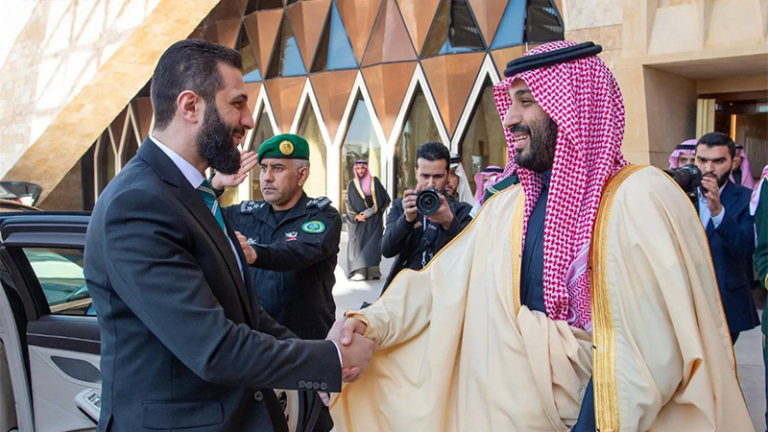
A large Saudi business delegation traveled to Syria on July 23-25, 2025, and participated in an inaugural Syrian-Saudi Investment Forum at the presidential palace in Damascus. Led by the Minister of Investment, Khalid al-Falih, the forum resulted in Saudi investments worth more than $6 billion across 47 agreements and in pledged commitments across a range of sectors including energy, infrastructure, telecommunications, and banking. Along with related initiatives, such as the granting of travel licenses for investors and businesspeople from both countries, the Damascus meeting underlined the depth of Saudi economic and political support for an otherwise embattled Syrian leadership. This support is anchored in a realistic assessment of the new government led by interim President Ahmed al-Sharaa and of Syria’s geopolitical importance in the region
Bringing Syria Back into the Fold of Arab Diplomacy
Like their regional and international counterparts, Saudi officials were taken by surprise at the speed and scale of the Assad regime’s collapse in the face of the 11-day offensive by al-Sharaa’s Hay’at Tahrir al-Sham (HTS) after it broke out of its Idlib stronghold in late November 2024. In a process of gradual normalization meant to draw Damascus back into the Gulf states’ sphere of influencehe Saudi leadership had reestablished diplomatic relations with the Assad regime in May 2023 after more than a decade of frozen ties. Neighboring Bahrain and the United Arab Emirates had already reopened their embassies in Syria in 2018, while Oman maintained relations with the Assad regime throughout the post-2011 period of uprising and civil war in Syria. But the Saudi move carried regional weight because of the kingdom’s standing within the Arab world and sent a strong geopolitical signal that the era of Assad’s international isolation was giving way to a more pragmatic approach to Syria.
The evolving Saudi position on Syria bridges the reconciliation with the Assad regime in 2023-24 and the pivot to the Ahmed al-Sharaa presidency in 2025. Years of fighting between Syrian government forces and rebel factions had resulted in a hollowed-out state that posed multiple security threats to its neighbors, most notably the growth of terrorist movements such as the so-called Islamic State (IS) and other groups such as Jabhat Al-Nusra, the al-Qaeda affiliate that was the precursor to HTS. Early flows of financial and logistical support from Gulf capitals to rebel groups in Syria by the mid-2010s had generated blowback as the Gulf states themselves became targets for IS attacks. In addition, the trafficking and smuggling of Captagon, a stimulant the production of which was controlled by members of the Assad family and their close associates, turned Syria into a narco-state, with Saudi Arabia as one of the largest illicit markets for the amphetamine trade.
Saudi Arabia reopened its embassy in Damascus on September 10, 2024—12 years after its closure— and on November 11, 2024, Bashar al-Assad traveled to Riyadh, where he participated in an Arab and Islamic Summit and met with Crown Prince Mohammed bin Salman (MBS), in his final foreign trip as president before his hasty visit to Russia in late November that preceded his final flight to exile in Moscow on December 8, 2024. These moves indicated that Saudi officials felt that a working relationship with a functioning Syrian counterpart was the best guarantor of its interests and the ‘least-bad’ option at the time. Ongoing frustration in Riyadh at the Assad regime’s failure to stop Captagon flows, as well as residual concerns at the level of Iranian influence in Syria, meant that the Saudis did not mourn the regime when it suddenly fell just weeks after Assad’s visit to the kingdom. Saudi authorities instead engaged with members of the Syrian transitional leadership. Notably, both the newly installed Minister of Foreign Affairs, Asaad al-Shaibani, and al-Sharaa himself chose the kingdom as the destination for their first official trips in office, on January 1 and February 2, 2025, respectively.
Saudi Arabia, the United States, and Syria: The Emerging Consensus
After Saudi Arabia’s initial provision of humanitarian aid and relief assistance in the immediate aftermath of Assad’s ousting and its expressions of cautious optimism following the first meetings with officials from the interim Syrian government, Saudi support for al-Sharaa kicked into high gear with a series of impactful and consequential decisions. During his visit to Saudi Arabia in May 2025, US President Donald Trump made the surprise announcement that he would lift American sanctions on Syria. Trump then met with al-Sharaa in Riyadh alongside Saudi Crown Prince bin Salman. Both moves appeared to have been facilitated by the Crown Prince and reportedly came as a surprise to many officials in the Trump administration, to say nothing of the wider community of Washington analysts. Indeed, when making the sanctions announcement during what the White House billed as his ‘major foreign policy address’ at the US-Saudi Investment Forum in Riyadh on May 13, 2025, Trump quipped, “Oh, what I do for the crown prince.” MBS’s decision to invite al-Sharaa to Saudi Arabia to meet Trump the following day sent a powerful regional signal, especially as it came after Israeli President Isaac Herzog had expressed his own desire to travel to Riyadh, but was unwelcomed.
Lifting the layers of sanctions imposed by multiple US administrations over decades was not as simple a process as Trump made it seem in his Riyadh speech. The Department of State placed Syria on the State Sponsors of Terrorism (SST) list in 1979; 40 years later, Congress imposed sanctions under the Caesar Act, which Trump signed into law in 2019 during his first term in the White House. Some of these sanctions cannot be unilaterally repealed by the president, but others imposed by executive order are easier to lift. On June 30, 2025, six weeks after his visit to Saudi Arabia and shortly after the end of the 12-day war between Israel and Iran that rocked the region, Trump issued an executive order that terminated the Syrian sanctions program and directed the Secretary of State to evaluate whether to suspend Caesar sanctions and to review Syria’s designation as a State Sponsor of Terrorism. On July 7, 2025, Secretary of State Marco Rubio duly declared that the HTS designation as a Foreign Terrorist Organization would be revoked, effective the following day.
Sanctions relief made it possible for Saudi Arabia and Qatar to settle Syria’s $15.5 million debt to the World Bank in May 2025 and for teams from the World Bank and the International Monetary Fund to re-engage with Damascus and begin the re-integration of Syria into the global economy. Saudi Arabia and Qatar, the two Gulf States most active in their support for al-Sharaa’s government, also announced that they would provide financial assistance to pay public sector salaries. These were highly practical measures designed to help with the gargantuan project of reconstructing the Syrian economy and infrastructure after 14 years of war. The same was true of the Syrian-Saudi Investment Forum, which initially was scheduled for June 2025 but was delayed until July 2024 by the war between Israel (and the United States) and Iran.
Rescheduling the Syrian-Saudi Investment Forum arguably had the fortuitous side effect of increasing the significance of the event’s geopolitical messaging. The show of Saudi support for Syrian reconstruction came after a torrid few weeks for the al-Sharaa government, which faced significant international criticism after the clashes in al-Suwayda in July that left more than 800 dead and thousands displaced. Along the earlier violence involving Alawi communities on the coast in March, the fighting in al-Suwayda highlighted the political transition’s vulnerability to communal tensions, and deepened a sense of fragility as Syria prepares to hold parliamentary elections in September 2025.
The Saudi display of support for Syria also carried an implicit rebuke of Israel following its airstrikes on Damascus on July 16, 2025, which hit the Ministry of Defense and other key targets in the city and was accompanied by Israeli threats to expand the bombing campaign if Syrian government forces did not withdraw from al-Suwayda. In language that they had previously used to describe Iran’s regional role, prominent Saudi commentators contrasted the Saudi approach to investing in Syria’s future with Israel’s reliance on the use of force and as a spoiler.
Reconstructing Syria in the Sphere of Saudi Influence
The arc of the approach of Saudi Arabia (and other Gulf states) to post-Assad Syria reaffirms the emphasis placed on containing flashpoints and on prioritizing economic growth and ambitious development projects. To be sure, the broader region is as unsettled in 2025 as it was in 2011, perhaps even more so considering the scale of destruction in Gaza and the apparent lack of constraints on the current Israeli government. The Gulf states, however, have learned lessons from their response to the Syrian uprising in 2011, when some of them worked at cross purposes and thereby contributed to regional tensions. The situation in 2011 was complicated by the atmosphere of geopolitical and sectarian competition at the time, and that dominated the landscape of regional politics for the rest of the decade. Since the COVID-19 pandemic, it has given way to a regional mood of pragmatic coexistence.
For Saudi leaders and their counterparts in other Gulf capitals, there is currently no option for Syria other than the al-Sharaa-led government, which they judge as preferable to the alternative of (renewed) state failure and disintegration into armed factions. Saudi Arabia and other Gulf states are betting that economic recovery can bolster the new government’s legitimacy and contribute to domestic stabilization, although the scale of reconstruction is enormous.
Saudi and other investment initiatives in Syria may take years to deliver results, but they indicate the constructive role that these states intend to play in Syria. They also amount to a declaration of support for an alternative regional vision to the hardline approach of undermining the al-Sharaa government that is advocated by Israel and its supporters in Washington. Strengthening ties with Damascus and pulling al-Sharaa’s Syria into a Saudi-centered regional orbit advance the Kingdom’s projection of interests in a still-contested regional environment. To the extent that Saudi engagement cements the kingdom’s influence with Syria’s new leadership, the results will not be displeasing to Riyadh as they dovetail with Iran’s weakened regional position following the post-October 7 wars.
The views expressed in this publication are the author’s own and do not necessarily reflect the position of Arab Center Washington DC, its staff, or its Board of Directors.
Featured image credit: SPA

